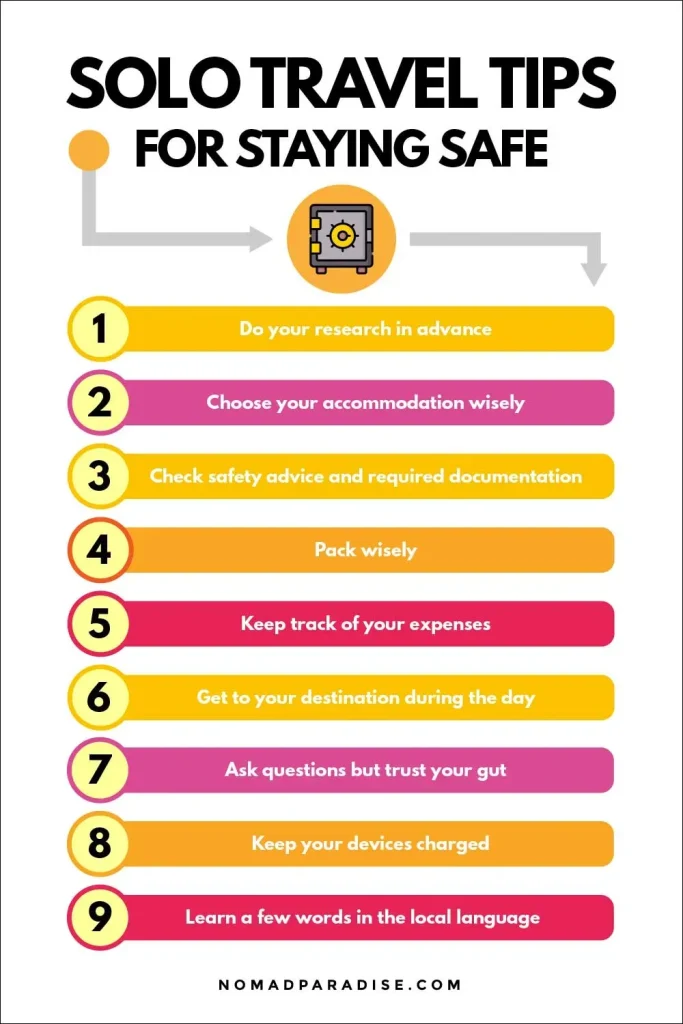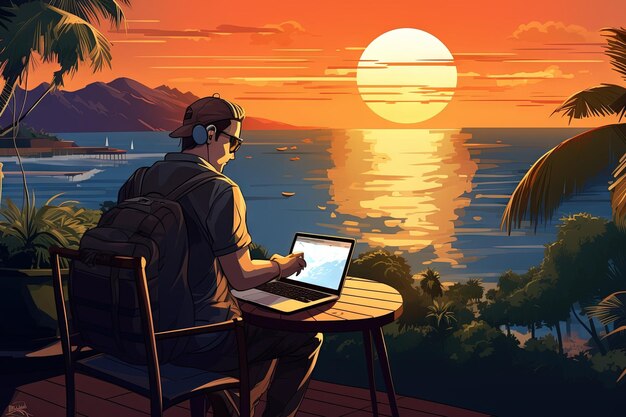Solo travel safety is not about dampening your sense of adventure; it’s about deliberate preparation that lets you explore with confidence. For first-time backpackers, thoughtful travel safety planning helps transform potential anxiety into practical steps, from route research to backups and clear communication with loved ones. A well-assembled packing list for solo travelers keeps essentials accessible while reducing clutter, and it doubles as a safety tool by ensuring you carry the right gear for weather, emergencies, and navigation. You’ll also benefit from simple backpacking safety tips, such as maintaining situational awareness, using trusted apps offline, and keeping important documents duplicated and secure. By weaving safety into everyday decisions—transport choices, lodging selections, and check-in routines—you can preserve the joy of discovery without overreacting to risk.
In alternative terms, independent travel safety reframes risk management as an active, everyday habit rather than a reaction to danger. This approach aligns with personal safety on the road, proactive risk awareness, and thoughtful trip planning that adapts to changing circumstances. By embracing self-reliant travel concepts—reliable information, practical backups, and clear communication—you set the stage for confident, enjoyable exploration. Framing safety as a toolkit of precautions rather than a constraint helps first-time explorers stay curious, resilient, and prepared on the road.
Solo Travel Safety for First-Time Backpackers: Planning, Packing, and Peace of Mind
For first-time backpackers, solo travel safety starts before you leave home. It’s a planning discipline: conduct destination risk assessment, read credible travel advisories, and map safe neighborhoods and transit options. Create a one-page safety brief that answers who to contact, where to go, what to avoid, and how you’ll return to your lodging if plans shift. This travel safety planning helps you act with prudence rather than hesitation, turning uncertainty into curiosity.
When it comes to packing, curate a lean packing list for solo travelers that supports both mobility and security. Choose lightweight clothing, a lockable backpack, a portable door alarm, a compact first-aid kit, offline maps, and a money belt for valuables. Pair gear decisions with digital safeguards: strong passwords, offline backups, and apps that work without constant connectivity. With these elements, you create a dependable baseline for solo travel safety that lets you focus on discovery.
Backpacking Safety Tips: On-the-Go Strategies for Staying Secure and Confident
On the move, safety is a practice you apply in real time. Favor reputable transport options, book through trusted apps, and avoid traveling through poorly lit or unfamiliar areas at night. Maintain situational awareness, keep valuables secured, and limit conspicuous displays of wealth. Prepare a simple response plan for uncomfortable encounters, and practice daily check-ins with a friend or mentor so someone back home knows your route and cadence.
Smart lodging choices and cautious social interactions complete your safety toolkit. Read reviews focused on security, use lockers in hostels, and never share sensitive plans with strangers. When meeting locals, exercise boundaries and favor public meetups in well-lit places until trust is established. Carry essential documents and emergency contact information offline, and know how to reach your embassy or consulate if needed. These habits, along with a prepared mindset, are the backbone of long-term backpacking safety tips that scale with your journeys.
Frequently Asked Questions
How should first-time backpackers approach travel safety planning to improve solo travel safety?
Travel safety planning for solo trips means pre-trip preparation to reduce risk while preserving the freedom of solo travel safety. For first-time backpackers, start with destination risk assessment using credible advisories, identify safe neighborhoods and reliable transit, and build a flexible itinerary. Share your plans with a trusted contact, schedule regular check-ins, and carry travel insurance plus digital and physical copies of important documents. Know local emergency numbers, keep emergency contacts handy, and maintain cultural awareness to stay aware and prepared.
What should be included in a packing list for solo travelers to maximize solo travel safety and preparedness?
A packing list for solo travelers should balance practicality with safety. Include: a lockable backpack; a compact first-aid kit and whistle; a portable door alarm; a money belt or hidden pouch; offline maps and a universal power adapter; multiple payment methods and some emergency cash; strong, unique passwords and offline data backups for digital safety. Also pack lightweight, multi-use clothing and gear suited to your climate, and organize items to reduce search time in unfamiliar places. This supports confident, safer backpacking safety and quick responses if plans change.
| Topic Area | Key Points Summary |
|---|---|
| Why Solo Travel Safety Matters | • Traveling alone increases exposure to risks and opportunities. • Rely on situational awareness, good habits, and trusted information. • Cultivate prudence, not paranoia, knowing when to act, whom to trust, and how to recover. |
| Pre-Trip Planning for First-Time Backpackers | • Build a solid foundation with three core areas: destination research, a flexible itinerary, and reliable communication. |
| Destination research and risk assessment | • Conduct a realistic risk assessment. • Check travel advisories, local safety norms, and traveler reviews mentioning safety concerns. • Identify safe neighborhoods, reliable transit, and areas to avoid after dark. • Create a one-page safety brief (where to go, what to avoid, contacts, return plan). |
| Flexible itinerary and backups | • Lock in must-see destinations but keep the rest flexible. • Have alternatives if a place feels unsafe or a route closes. • Share your itinerary with a trusted contact and schedule daily check-ins. |
| Insurance, documents, and money management | • Obtain travel insurance for medical, interruptions, and lost belongings. • Make digital and physical copies of important documents. • Carry multiple payment methods and some emergency cash in local currency. |
| Packing and Gear for Safety | • Pack lightweight, practical items that support mobility, comfort, and security. • Essentials: lockable backpack, first-aid kit, a whistle, door alarm, flashlight, money belt, universal adapter, offline maps. |
| Packing list for solo travelers: practical tips | • Prioritize multi-use items, quick-dry fabrics, and layerable clothing. • Use an organized packing method to locate items easily; bring travel-sized toiletries and consider a compact sleeping system for hostels. |
| Digital safety and awareness while traveling solo | • Use strong, unique passwords; enable two-factor authentication; avoid sensitive transactions on public Wi‑Fi. • Lock devices, limit real-time personal data on social networks, and consider offline backups and offline maps. |
| Staying safe on the move: transportation and public spaces | • Choose reputable transport and trusted apps; avoid traveling alone in poorly lit or unfamiliar areas at night. • Maintain situational awareness, don’t display valuables, keep your pack secure, and trust your instincts. |
| Safe lodging for first-time backpackers | • Read reviews focused on safety, security, and management responsiveness. • In shared dorms, use lockers and keep valuables secure; avoid oversharing plans. |
| Meeting locals and social safety | • Be cautious of schemes that seem too good to be true; avoid sharing full itineraries or home addresses too soon. • Set boundaries, meet in public places, and build trust gradually. |
| Emergency preparation and local contacts | • Know local emergency numbers and your country’s embassy/consulate location. • Save local emergency contacts and have a plan for lost documents; share plans with someone back home. |
| Cultural awareness and personal safety practices | • Respect local customs, dress appropriately, learn a few phrases in the local language. • Balance keeping a low profile with staying visible in public spaces to deter crime. |
| The Mindset of a Prepared Backpacker | • Adopt a proactive mindset; rehearse scenarios and outline response steps. • Regularly assess risks and adjust plans to maintain a joyful exploration mindset. |
| Putting it All Together: Routine Safety Checks | • Create a daily safety checklist (check accommodations’ safety features, plan routes, confirm meeting points, secure documents) and weave safety into your routine. |
Summary
HTML table of key solo travel safety points (in English) followed by a descriptive conclusion.



